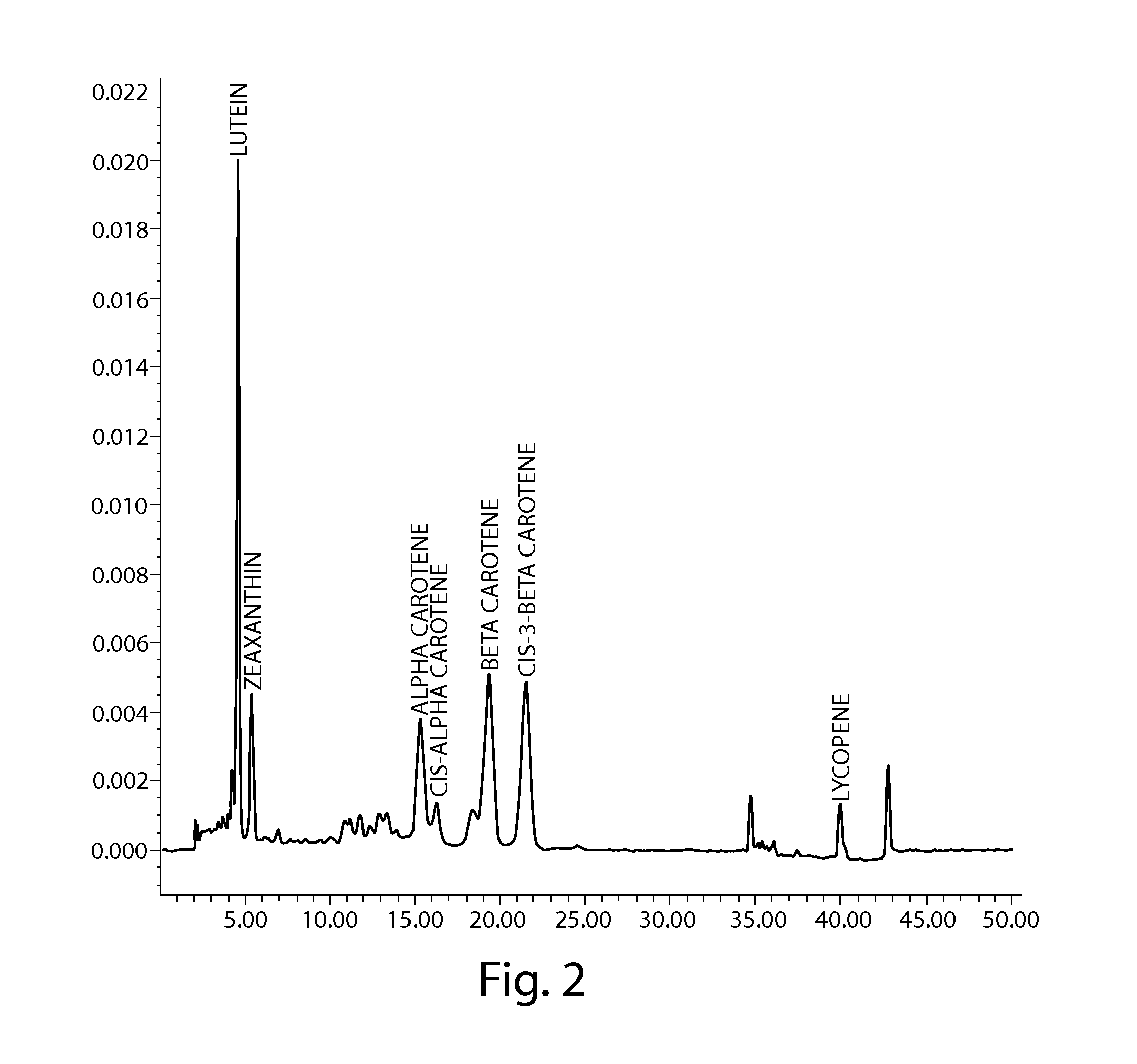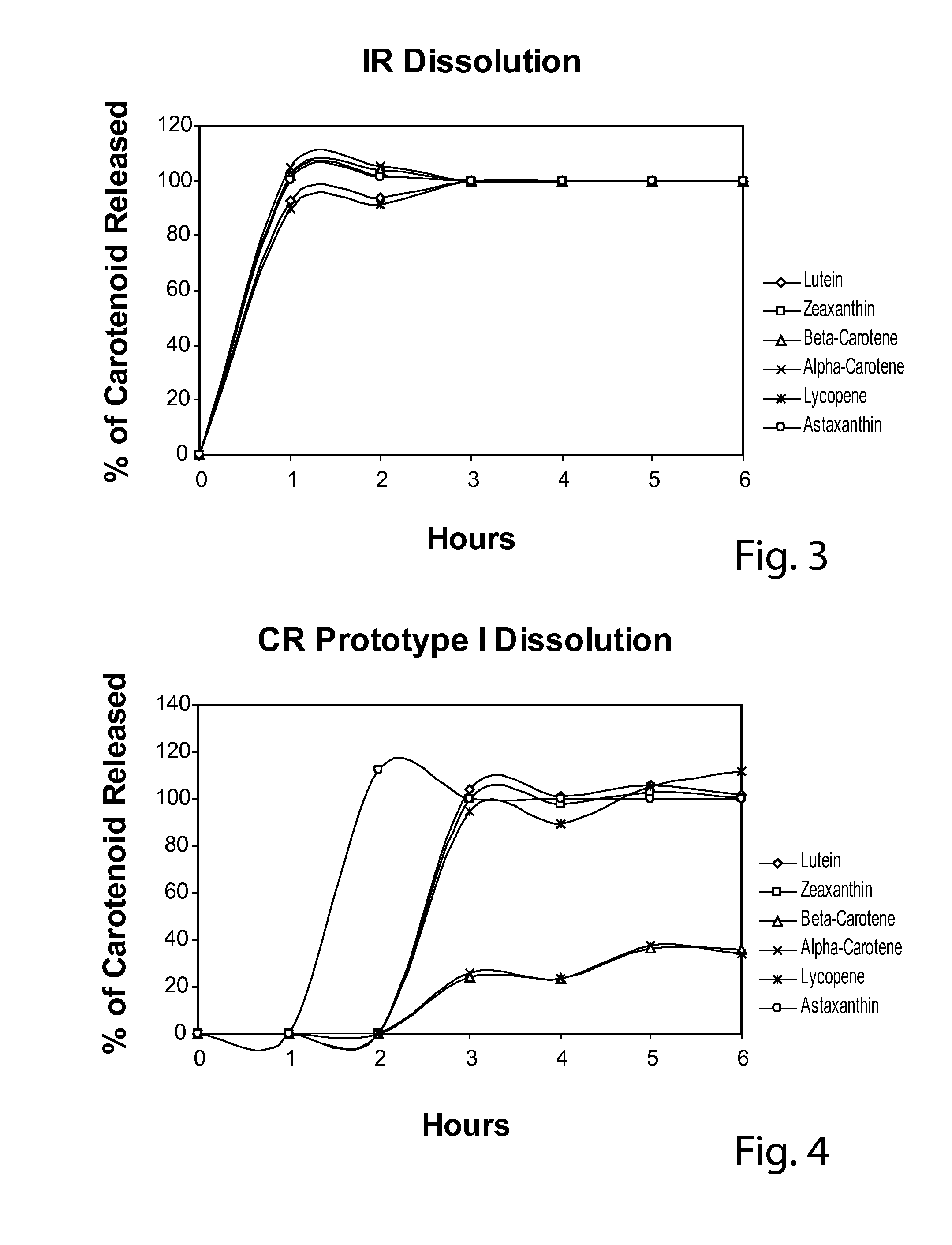Multicarotenoid beadlets and related method
a multi-carotenoid and bead technology, applied in the field of multi-carotenoid beadlets and related methods, can solve the problems of unfavorable optimal health of human dietary intake of fruits and vegetables, supplementation suffers some problems, supraphysiological doses of individual carotenoids are unexpected and worrisome, etc., to achieve the maximum bioavailability of individual carotenoids and constrain competition for micelles
- Summary
- Abstract
- Description
- Claims
- Application Information
AI Technical Summary
Benefits of technology
Problems solved by technology
Method used
Image
Examples
example 1
[0039]Multicarotenoid beadlets having the multiple layer construction described above in connection with FIG. 1, and the constructions shown in Table 1, or other constructions as described below, were prepared and then tested for dissolution. FIG. 2 illustrates a representative chromatogram of such a sequential, timed release beadlet. The protocol to obtain this data is described in Table 3 and further below.
[0040]
TABLE 3Dissolution Parameters and ProcedureDissolution medium volume500mlTypeUSP Type II PaddleRPM100Temperature37° C. + / − 0.5° C.Time Intervals2 hrs in 0.1N HCl, continued with 6 hrs inpH 6.8 buffer with 1.5% SLSSampling TimeHourly for 8 hoursAliquots Volume20mlAliquots replenish volume20mlBeadlet quantity700mg
[0041]The above aliquots of beadlet samples in Table 3 were subjected to a high performance liquid chromatography (HPLC) analysis. The standard for the HPLC analysis was β-carotene, Type II Synthetic, Sigma Aldrich, Cat #C4582-25MG, Lot #120M5165V, Purity: 99.840%, ...
example 2
[0046]In this example, the carotenoid composition of an immediate release (IR) multicarotenoid formulation, that is, one where individual carotenoids are not layered and not released sequentially, but instead, released all simultaneously, was compared to two embodiments of sequential, timed release, also referred to as controlled release (CR), multicarotenoid beadlets. The precise amounts of the respective carotenoids from each formulation are represented in milligrams per gram (mg / g) in Table 5 below. FIGS. 3-5 illustrate the dissolution profiles of the immediate release (IR) beadlet (FIG. 3) and two embodiments of controlled release (CR) beadlets, referred to as Prototype I (FIG. 4) and Prototype II (FIG. 5). As illustrated, there is a difference in release of β-carotene and α-carotene between Prototypes I and II.
[0047]
TABLE 5Composition of Immediate (IR) and ControlledRelease (CR) Beadlets (mg / g)IR PrototypeCR Prototype 1CR Prototype 2β-carotene34.3016.3418.83Lutein20.738.8010.52...
example 3
[0049]A clinical study comparing immediate release multicarotenoid formulations and controlled release multicarotenoid formulations will be performed. This clinical study will be designed based on the following. Within the intestinal tract, carotenoids form into multilamellar lipid vesicles, those mixed lipid micelles composed of bile salts, free fatty acids, monoglycerides and phospholipids. Once formed into micelles, carotenoids are generally considered to be absorbed into duodenal mucosal cells by passive diffusion. The rate of diffusion is determined by a concentration gradient between the micelle and the enterocyte. Carotenoids are transported from the intestinal mucosa to the blood stream exclusively by the chylomicrons. This provides a convenient compartment type model, with which to assess carotenoid uptake after consumption.
[0050]Thus, in the study, the post-prandial chylomicron fractions of the plasma will be assessed to determine the uptake after release from the vehicle ...
PUM
| Property | Measurement | Unit |
|---|---|---|
| transit time | aaaaa | aaaaa |
| wavelengths | aaaaa | aaaaa |
| wavelengths | aaaaa | aaaaa |
Abstract
Description
Claims
Application Information
 Login to View More
Login to View More - R&D
- Intellectual Property
- Life Sciences
- Materials
- Tech Scout
- Unparalleled Data Quality
- Higher Quality Content
- 60% Fewer Hallucinations
Browse by: Latest US Patents, China's latest patents, Technical Efficacy Thesaurus, Application Domain, Technology Topic, Popular Technical Reports.
© 2025 PatSnap. All rights reserved.Legal|Privacy policy|Modern Slavery Act Transparency Statement|Sitemap|About US| Contact US: help@patsnap.com



